FREE FIBULAR OSTEOCUTANEOUS FLAP DONOR SIDE SELECTION IN RECONSTRUCTION OF COMPOSITE OROMANDIBULAR DEFECTS AFTER CANCER RESECTION
Main Article Content
Abstract
Objective: The purpose of this study is to present our experience in selecting the donor site for free fibular osteocutaneous flap in oromandibular reconstruction after cancer resection. Methods: This is a retrospective review of 63 cases who had maxillofacial cancer resected and were reconstructed by free osteocutaneous fibular flap in Department of Plastic and Aesthetic Surgery, Hanoi National Hospital of Odonto – Stomatology from May 2014 to August 2017. Results: When placing the skin paddle of osteocutaneous fibular flap inside the oral cavity for providing mucosal lining, we choose the contralateral fibular flap. When placing the skin paddle outside to provide skin cover, we choose the ipsilateral one. And when the lesion was on the middle, we often choose the non-dominant leg, as long as there was no contraindication of fibular flap harvest. Totally, there were 27 cases with fibular flap harvested from right leg and 36 cases were harvested from left leg. The total flap failure ratio was 3.2% and no case has partial flap failure. Conclusion: Free fibular flap donor side selection will depend on surgeons’ preference, especially when muscular component was not included. However, respect of flap components’ position as described above can significantly contribute to success of operation.
Article Details
Keywords
fibular osteocutaneous flap, donor site selection, composite oromandibular defect
References
2. S. M. Fu-Chan Wei MD, Flaps and Reconstructive Surgery, 2nd edition. Elsevier, 2016.
3. S. Yagi, Y. Kamei, and S. Torii, “Donor side selection in mandibular reconstruction using a free fibular osteocutaneous flap,” Ann Plast Surg, vol. 56, no. 6, Art. no. 6, Jun. 2006, doi: 10.1097/01.sap.0000205776.18090.9b.
4. M. Sharma et al., “Anatomic basis for an algorithmic approach for free fibula flap donor side selection in composite oro-mandibular defects,” Indian J Plast Surg, vol. 48, no. 1, pp. 43–47, Apr. 2015, doi: 10.4103/0970-0358.155268.
5. J. M. López-Arcas et al., “The fibula osteomyocutaneous flap for mandible reconstruction: a 15-year experience,” J Oral Maxillofac Surg, vol. 68, no. 10, pp. 2377–2384, Oct. 2010, doi: 10.1016/j.joms.2009.09.027.
6. Nguyễn Quang Đức, “Nghiên cứu sử dụng vạt xương mác tự do có nối mạch nuôi trong tạo hình mất đoạn lớn xương hàm dưới,” Luận án tiến sĩ Y học, Viện nghiên cứu khoa học y dược lâm sàng 108, 2011.
7. O. Camuzard et al., “Primary radical ablative surgery and fibula free-flap reconstruction for T4 oral cavity squamous cell carcinoma with mandibular invasion: oncologic and functional results and their predictive factors,” Eur Arch Otorhinolaryngol, vol. 274, no. 1, Art. no. 1, Jan. 2017, doi: 10.1007/s00405-016-4219-7.
8. B. Swendseid et al., “Long-Term Complications of Osteocutaneous Free Flaps in Head and Neck Reconstruction,” Otolaryngol Head Neck Surg, vol. 162, no. 5, pp. 641–648, May 2020, doi: 10.1177/0194599820912727.


